brake VAUXHALL COMBO 2014 Owner's Manual
[x] Cancel search | Manufacturer: VAUXHALL, Model Year: 2014, Model line: COMBO, Model: VAUXHALL COMBO 2014Pages: 187, PDF Size: 4.15 MB
Page 18 of 187
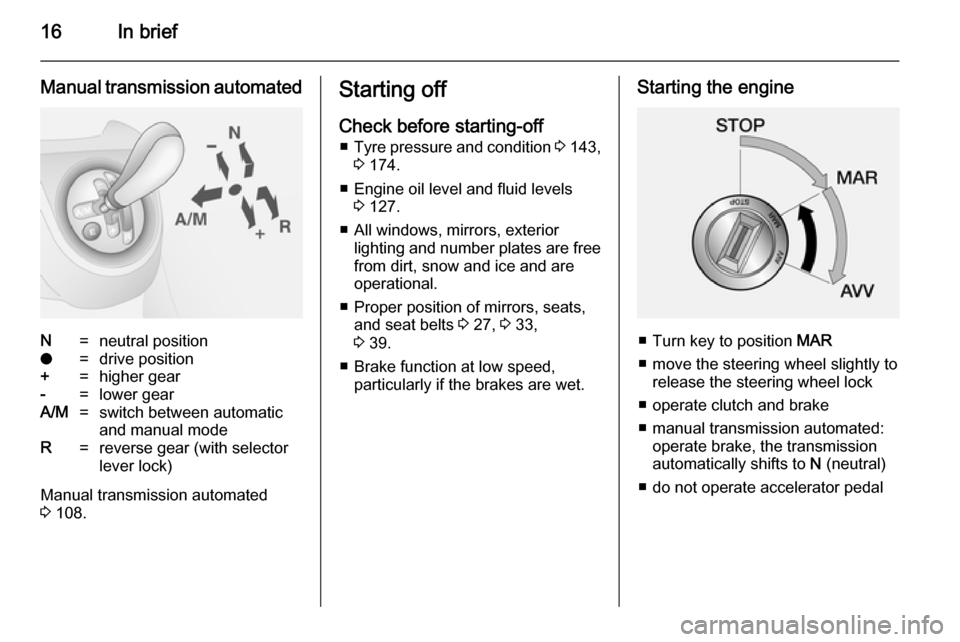
16In brief
Manual transmission automatedN=neutral positiono=drive position+=higher gear-=lower gearA/M=switch between automatic
and manual modeR=reverse gear (with selector
lever lock)
Manual transmission automated
3 108.
Starting off
Check before starting-off ■ Tyre pressure and condition 3 143,
3 174.
■ Engine oil level and fluid levels 3 127.
■ All windows, mirrors, exterior lighting and number plates are free
from dirt, snow and ice and are
operational.
■ Proper position of mirrors, seats, and seat belts 3 27, 3 33,
3 39.
■ Brake function at low speed, particularly if the brakes are wet.Starting the engine
■ Turn key to position MAR
■ move the steering wheel slightly to release the steering wheel lock
■ operate clutch and brake
■ manual transmission automated: operate brake, the transmission
automatically shifts to N (neutral)
■ do not operate accelerator pedal
Page 19 of 187
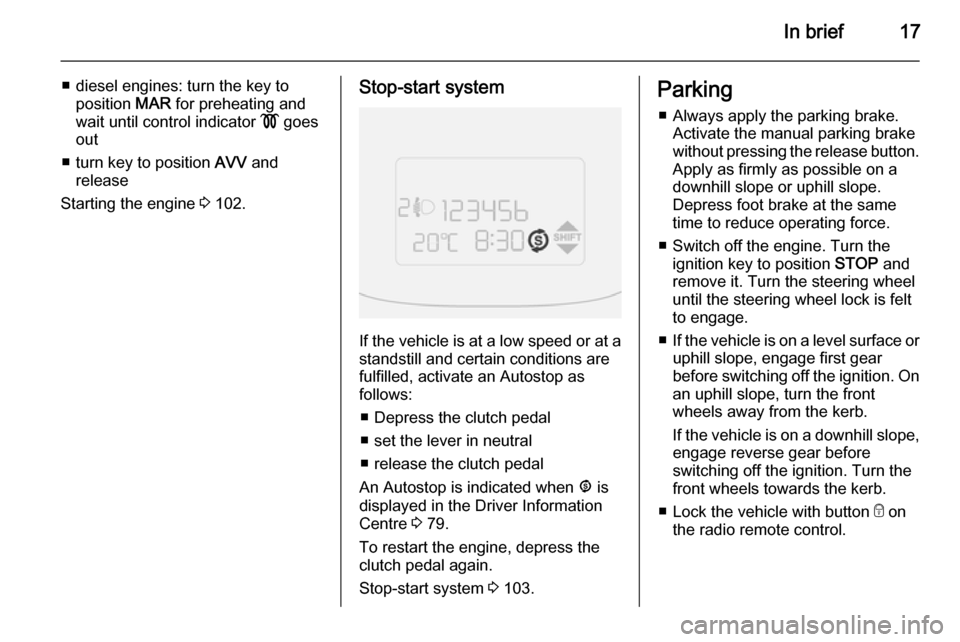
In brief17
■ diesel engines: turn the key toposition MAR for preheating and
wait until control indicator ! goes
out
■ turn key to position AVV and
release
Starting the engine 3 102.Stop-start system
If the vehicle is at a low speed or at a
standstill and certain conditions are
fulfilled, activate an Autostop as
follows:
■ Depress the clutch pedal
■ set the lever in neutral
■ release the clutch pedal
An Autostop is indicated when ^ is
displayed in the Driver Information
Centre 3 79.
To restart the engine, depress the
clutch pedal again.
Stop-start system 3 103.
Parking
■ Always apply the parking brake. Activate the manual parking brake
without pressing the release button.
Apply as firmly as possible on a
downhill slope or uphill slope.
Depress foot brake at the same
time to reduce operating force.
■ Switch off the engine. Turn the ignition key to position STOP and
remove it. Turn the steering wheel
until the steering wheel lock is felt
to engage.
■ If the vehicle is on a level surface or
uphill slope, engage first gear
before switching off the ignition. On
an uphill slope, turn the front
wheels away from the kerb.
If the vehicle is on a downhill slope, engage reverse gear before
switching off the ignition. Turn the
front wheels towards the kerb.
■ Lock the vehicle with button e on
the radio remote control.
Page 61 of 187

Storage59
To fasten a roof rack, insert the
mounting bolts in the holes indicated
in the illustration.Loading information
■ Heavy objects in the load compartment should be evenly
distributed and placed as far
forward as possible. If objects can
be stacked, the heavier objects
should be placed at the bottom.
■ Secure objects with lashing straps attached to lashing eyes 3 58.
■ Secure loose objects in load compartment to prevent them from
sliding.
■ When transporting objects in the load compartment, the backrests ofthe rear seats must not be tilted
forwards or folded down.
■ Do not allow the load to protrude above the upper edge of the
backrests.
■ Do not place any objects on the extendable load compartment
cover 3 55 or the instrument panel,
and do not cover the sensor on top
of the instrument panel 3 97.■ The load must not obstruct the
operation of the pedals, parking
brake and gear selector, or hinder
the freedom of movement of the
driver. Do not place any unsecured objects in the interior.
■ Do not drive with an open load compartment.9 Warning
Always make sure that the load in
the vehicle is securely stowed.
Otherwise objects can be thrown
around inside the vehicle and
cause personal injury or damage
to the load or car.
■ The payload is the difference between the permitted gross
vehicle weight (see identification
plate 3 161) and the EC kerb
weight.
To calculate the payload, enter the
data for your vehicle in the Weights
table at the front of this manual.
The EC kerb weight includes
weights for the driver (68 kg),
Page 76 of 187
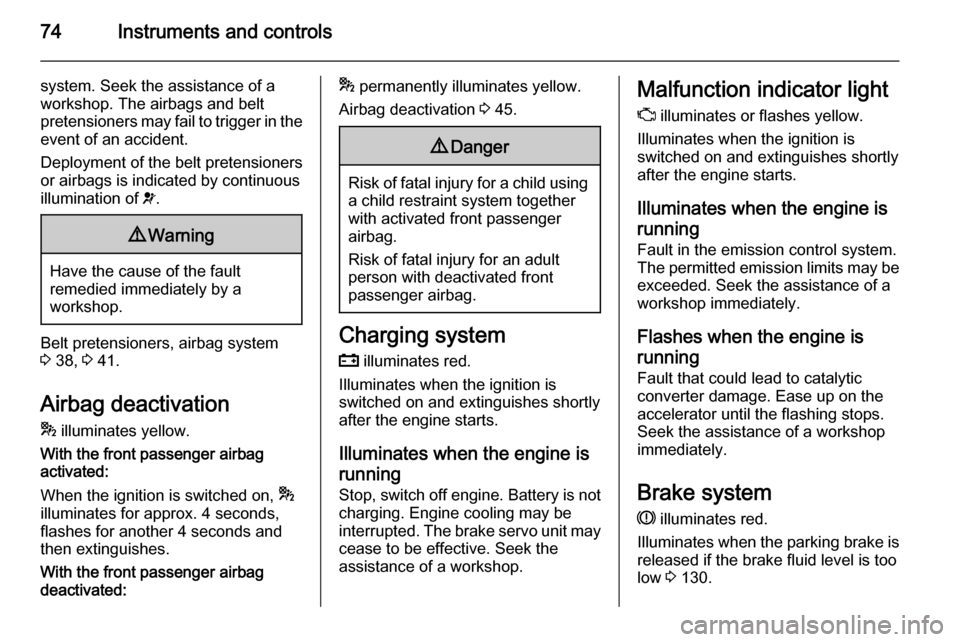
74Instruments and controls
system. Seek the assistance of a
workshop. The airbags and belt
pretensioners may fail to trigger in the
event of an accident.
Deployment of the belt pretensioners
or airbags is indicated by continuous
illumination of v.9 Warning
Have the cause of the fault
remedied immediately by a
workshop.
Belt pretensioners, airbag system
3 38, 3 41.
Airbag deactivation
* illuminates yellow.
With the front passenger airbag
activated:
When the ignition is switched on, *
illuminates for approx. 4 seconds,
flashes for another 4 seconds and
then extinguishes.
With the front passenger airbag
deactivated:
* permanently illuminates yellow.
Airbag deactivation 3 45.9 Danger
Risk of fatal injury for a child using
a child restraint system together
with activated front passenger
airbag.
Risk of fatal injury for an adult
person with deactivated front
passenger airbag.
Charging system
p illuminates red.
Illuminates when the ignition is
switched on and extinguishes shortly
after the engine starts.
Illuminates when the engine is
running
Stop, switch off engine. Battery is not
charging. Engine cooling may be
interrupted. The brake servo unit may
cease to be effective. Seek the
assistance of a workshop.
Malfunction indicator light
Z illuminates or flashes yellow.
Illuminates when the ignition is
switched on and extinguishes shortly after the engine starts.
Illuminates when the engine is running Fault in the emission control system.
The permitted emission limits may be
exceeded. Seek the assistance of a
workshop immediately.
Flashes when the engine is
running
Fault that could lead to catalytic converter damage. Ease up on the
accelerator until the flashing stops.
Seek the assistance of a workshop
immediately.
Brake system R illuminates red.
Illuminates when the parking brake is
released if the brake fluid level is too
low 3 130.
Page 77 of 187

Instruments and controls759Warning
Stop. Do not continue your
journey. Consult a workshop.
Illuminates if the brake vacuum servo
fails; the brake pedal becomes stiff
when pressed. The brake system
remains operational however,
assistance will be reduced. The
steering may also require
considerably more effort when
turning.
Illuminates after the ignition is
switched on if the parking brake is
applied 3 112.
Brake pad wear F illuminates yellow.
The front brake pads are worn, seek
the assistance of a workshop
immediately.
Antilock brake system
(ABS)
u illuminates yellow.
Illuminates for a few seconds after the
ignition is switched on. The system is
ready for operation when the control
indicator extinguishes.
If the control indicator does not
extinguish after a few seconds, or if it illuminates while driving, there is a
fault in the ABS. The brake system
remains operational but without ABS
regulation.
Antilock brake system 3 112.
Upshift [ or Ò illuminates in the Driver
Information Centre 3 79 when
gearshifting is recommended to
improve fuel economy.
Hill start assist
Z illuminates yellow.
Illuminates when the ignition is
switched on and extinguishes shortly
after the engine starts.
If the control indicator does not
extinguish after a few seconds, or if it illuminates while driving, there is afault in the Hill start assist. Seek the
assistance of a workshop to have the
fault remedied.
The Electronic Stability Program
(ESP) control indicator x may also
illuminate 3 76 in conjunction with
Z .
Depending on model variant, 9 will
illuminate as an alternative if control
indicator Z is not present. A warning
message may also be displayed in
the Driver Information Centre 3 79.
Generic warning 9 3 73.
Hill start assist 3 113.
Ultrasonic parking assist r illuminates yellow.
Fault in system
or
Fault due to sensors that are dirty or
covered by ice or snow
or
Page 78 of 187

76Instruments and controls
Interference due to external sources
of ultrasound. Once the source of
interference is removed, the system
will operate normally.
Have the cause of the fault in the
system remedied by a workshop.
Depending on version, 9 will
illuminate as an alternative if control
indicator r is not present. A
warning message may also be
displayed in the Driver Information
Centre 3 79.
Generic warning 9 3 73.
Ultrasonic parking assist 3 116.
Electronic Stability
Program
x illuminates or flashes yellow.
Flashes
The system is actively engaged.
Engine output may be reduced and
the vehicle may be braked
automatically to a small degree.Illuminates
A fault in the system is present.
Continued driving is possible. Driving
stability, however, may deteriorate
depending on road surface
conditions.
Have the cause of the fault remedied
by a workshop.
Electronic Stability Program (ESP)
3 114, Traction control system/Anti-
Slip Regulator (ASR) 3 113.
Engine coolant
temperature $ illuminates red.
Illuminates for a few seconds after the ignition is switched on.
If control indicator $ illuminates in
conjunction with a message in the
Driver Information Centre, the coolant
temperature is too high. Seek the
assistance of a workshop.
Driver Information Centre 3 79.Caution
If engine coolant temperature is
too high, stop vehicle, switch off
the ignition. Danger to engine.
Check coolant level.
If the control indicator remains on, seek the assistance of your
workshop.
Engine coolant temperature gauge
3 69.
Preheating ! illuminates yellow.
Preheating is activated. Only
activates when outside temperature
is low.
Diesel particle filter
[ illuminates yellow.
The diesel particle filter requires
cleaning.
Page 79 of 187
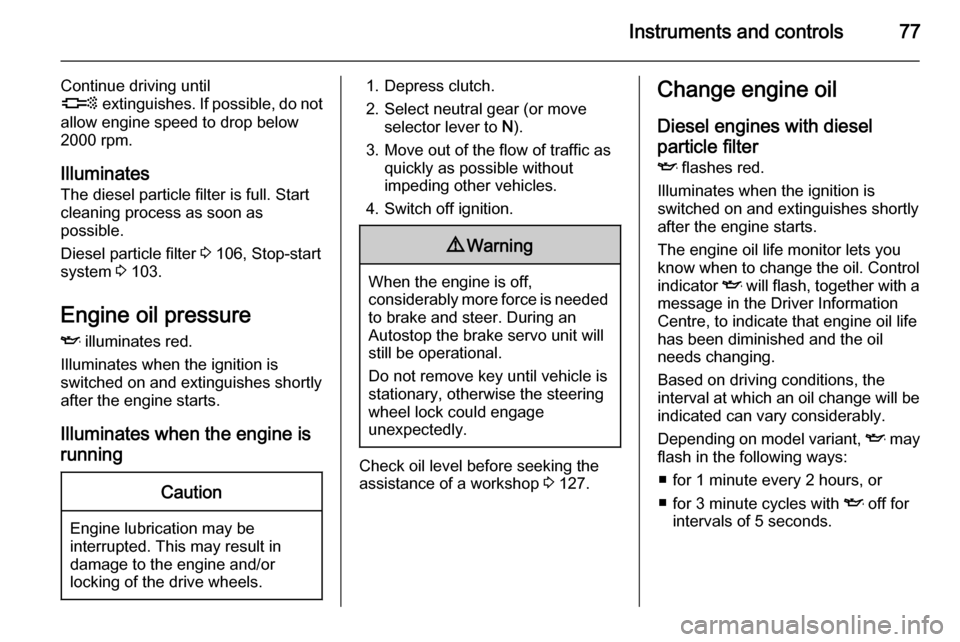
Instruments and controls77
Continue driving until
[ extinguishes. If possible, do not
allow engine speed to drop below
2000 rpm.
Illuminates The diesel particle filter is full. Start
cleaning process as soon as
possible.
Diesel particle filter 3 106, Stop-start
system 3 103.
Engine oil pressure
I illuminates red.
Illuminates when the ignition is
switched on and extinguishes shortly
after the engine starts.
Illuminates when the engine is runningCaution
Engine lubrication may be
interrupted. This may result in
damage to the engine and/or
locking of the drive wheels.
1. Depress clutch.
2. Select neutral gear (or move selector lever to N).
3. Move out of the flow of traffic as quickly as possible without
impeding other vehicles.
4. Switch off ignition.9 Warning
When the engine is off,
considerably more force is needed
to brake and steer. During an
Autostop the brake servo unit will still be operational.
Do not remove key until vehicle is stationary, otherwise the steeringwheel lock could engage
unexpectedly.
Check oil level before seeking the
assistance of a workshop 3 127.
Change engine oil
Diesel engines with dieselparticle filter
I flashes red.
Illuminates when the ignition is
switched on and extinguishes shortly
after the engine starts.
The engine oil life monitor lets you know when to change the oil. Control
indicator I will flash, together with a
message in the Driver Information
Centre, to indicate that engine oil life
has been diminished and the oil
needs changing.
Based on driving conditions, the
interval at which an oil change will be
indicated can vary considerably.
Depending on model variant, I may
flash in the following ways:
■ for 1 minute every 2 hours, or
■ for 3 minute cycles with I off for
intervals of 5 seconds.
Page 87 of 187

Instruments and controls85Vehicle messages
Warning chimes
Only one warning chime will sound at a time.
The warning chime regarding
unfastened seat belts has priority
over any other warning chime.
When starting the engine or
whilst driving ■ If seat belt is not fastened.
■ If a certain speed is exceeded with the parking brake applied.
■ If the parking assist detects an object.
■ If a fault is detected in the parking assist.
■ If a door or the tailgate is not fully closed when starting-off.
■ If the vehicle speed briefly exceeds
a set limit.
■ Vehicles with manual transmission automated; neutral is not selectedor the foot brake has not been
depressed.■ If a transmission fault is detected in
vehicles with manual transmission
automated.
■ If a warning message appears in the Driver Information Centre.
When the vehicle is parked
and/or the driver's door is
opened ■ When the key is in the ignition switch.
■ Vehicles with manual transmission automated; neutral is not selected,
the parking brake is not applied, or
the foot brake and/or the
accelerator pedal has not been
depressed.
Fuel system messages
Fuel cut-off system
In the event of a collision of a certain
severity, the fuel system is cut-off and
the engine is switched off
automatically, for safety reasons. A
corresponding warning message may also appear in the Driver Information
Centre 3 79.To reset the fuel cut-off system and
enable the vehicle to be driven, refer
to " Vehicle shutdown " 3 103.
Page 103 of 187

Driving and operating101Driving and operatingDriving hints............................... 101
Starting and operating ...............101
Engine exhaust .......................... 106
Manual transmission ..................107
Manual transmission automa‐
ted .............................................. 108
Brakes ........................................ 112
Ride control systems .................113
Cruise control ............................. 115
Object detection systems ........... 116
Fuel ............................................ 118
Towing ....................................... 123Driving hints
Control of the vehicleNever coast with engine not
running (except during Autostop)
Many systems will not function in this
situation ( e.g. brake servo unit, power
steering). Driving in this manner is a
danger to yourself and others. All
systems function during an Autostop,
but there will be a controlled reduction
in power steering assist and vehicle
speed is reduced.
Stop-start system 3 103.
Pedals
To ensure the pedal travel is
uninhibited, there must be no mats in the area of the pedals.Starting and operating
New vehicle running-in Do not brake unnecessarily hard for
the first few journeys.
During the first drive, smoke may
occur because of wax and oil
evaporating off the exhaust system. Park the vehicle in the open for a
while after the first drive and avoid
inhaling the fumes.
During the running-in period fuel and engine oil consumption may be
higher and the cleaning process of the diesel particle filter may take
place more often. Autostop may be inhibited to allow for charging the
battery.
Diesel particle filter 3 106.
Page 104 of 187
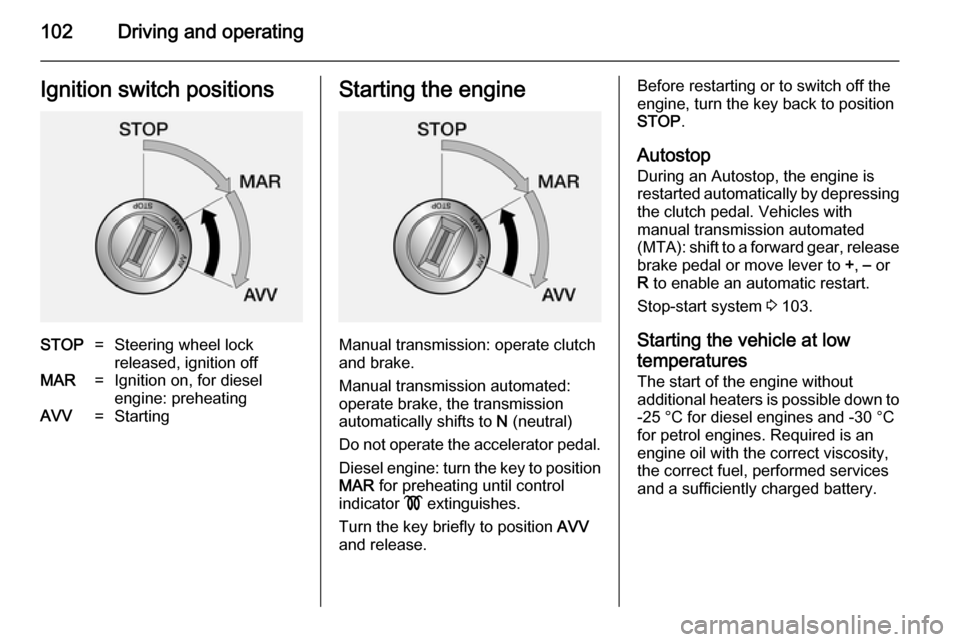
102Driving and operatingIgnition switch positionsSTOP=Steering wheel lock
released, ignition offMAR=Ignition on, for diesel
engine: preheatingAVV=StartingStarting the engine
Manual transmission: operate clutch
and brake.
Manual transmission automated: operate brake, the transmission
automatically shifts to N (neutral)
Do not operate the accelerator pedal. Diesel engine: turn the key to positionMAR for preheating until control
indicator ! extinguishes.
Turn the key briefly to position AVV
and release.
Before restarting or to switch off the
engine, turn the key back to position
STOP .
Autostop
During an Autostop, the engine is
restarted automatically by depressing the clutch pedal. Vehicles with
manual transmission automated
(MTA): shift to a forward gear, release
brake pedal or move lever to +, – or
R to enable an automatic restart.
Stop-start system 3 103.
Starting the vehicle at low
temperatures The start of the engine without
additional heaters is possible down to
-25 °С for diesel engines and -30 °C
for petrol engines. Required is an
engine oil with the correct viscosity,
the correct fuel, performed services
and a sufficiently charged battery.